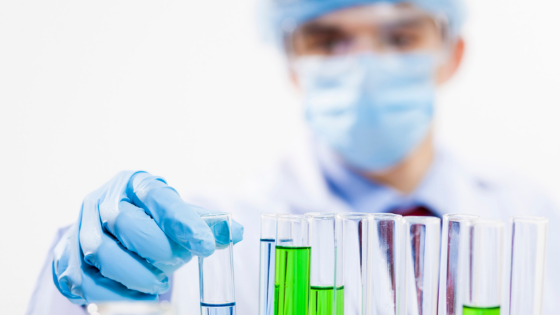Are your cosmetics & personal care products messing with your hormones?
Posted by Naturally Safe Cosmetics on 9th Feb 2019
In this article, I’ll be looking at Endocrine Disrupting Chemicals or EDCs as they are commonly known. These are chemicals used in everyday products that are known for their ability to interfere with your normal hormonal processes.

Can ingredients in personal care products interfere with hormones? Image source: Canva
What is the Endocrine System?
Let’s start with our endocrine system. What is it? The endocrine system is a collection of glands that produce hormones.
What do hormones do?
Hormones are regulatory substances produced in our bodies that are transported in tissue fluids like blood to stimulate specific cells or tissues into action. They regulate nearly every process in the body. This includes body functions such as digestion and metabolism, growth, repair, development, tissue function, sexual function, reproduction, sleep and more. A hormone only acts on a part of the body it ‘fits’. It’s a bit like a key (the hormone) fitting into a specially shaped lock (found on the cell wall of its target organ). If the hormone fits the cell wall, then it will work on that organ. The endocrine system is tightly regulated to keep the hormones and their effects on our bodies at just the right level. Hormone release is regulated by other hormones, proteins or neuronal signals. It’s all connected like a big system of ‘loops’.
How do EDCs affect our endocrine system?
EDCs can mimic, block or interfere with our natural hormones. They can mimic oestrogens (female sex hormone), androgens (male sex hormones) and thyroid hormones, potentially producing overstimulation. They can also bind to a receptor within a cell and block the normal hormone from binding.
What happens when EDCs disrupt hormonal processes?
EDCs messing with the normal hormonal processes in our bodies can wreak havoc on the entire endocrine system and this can lead to a whole host of serious and chronic health issues, including:
- sperm quality
- fertility
- abnormalities in sex organs
- endometriosis
- early puberty
- nervous system function
- immune system function
- metabolic issues
- breathing problems
- cancer
- heart health problems
- obesity
- growth issues
- learning disabilities
This list goes on, but you get the idea.
Who is most vulnerable?
EDCs can cause adverse health problems in anyone at any time but it is thought that the following are most vulnerable:
- foetuses
- children
- pregnant women
- adolescents
- the elderly
The really concerning thing is that a long time can pass between exposure and manifestation of health issues – even generations. EDC exposure of a pregnant woman can act on the woman herself, her foetus and on the foetal gametes, thereby affecting 3 generations. It is thought that individuals exposed in the womb face a greater risk of disease later in life. Scary stuff, I know!
How are we exposed to EDCs?
In our modern world, exposure to EDCs happens from multiple sources. EDCs can be found in materials used in your home, the foods you eat, your water, the products you put on our skin and even the air you breathe. It may seem like it’s impossible to avoid entirely but there are steps you can take to reduce your level of exposure, including the choices you make when it comes to buying food, drinks and products for use on your body. When it comes to beauty products and personal care items, opt for 'genuine' natural and organic brands, even certified organic products, which steer clear of known nasties.
What ingredients should you try to avoid in cosmetics & personal care products?
As far as the products you put on our skin are concerned, there are, unfortunately, many chemicals of concern and too many to mention here. Some of the ones I’m listing here are known for other health issues too, like cancer, so even more reason to avoid them. And, too, there’s so much more to know about each of them but it's too much detail for this article so I urge you to do your own research for more information. Here they are:
- Bisphenol A (BPA) – found in polycarbonate plastics (plastic food & drink containers), linings of food cans and jar lids
- Phthalates – plasticisers found in perfumes, lotions, nail polish, e.g. Dibutyl Phthalate (DBP) – also linked to cancer and long-term fertility problems in newborn boys
- Parabens – preservatives, e.g. Methylparaben, Propylparaben, Ethylparaben, Butylparaben, Isobutylparaben – also linked to breast cancer
- Triclosan – antibacterial agent and preservative found in antibacterial soap & hand wash, toothpaste and other personal care products – also thought to contribute to antibiotic resistance (now banned in the US for use in antibacterial soaps/washes)
- Resorcinol – used in hair dyes to produce permanent colour, also in topical treatments for acne, seborrhoeic dermatitis, eczema & psoriasis
As mentioned, there are many more chemicals of concern when it comes to the products you (and your family) use on your body on a daily basis and the potential effects on your endocrine system. Hopefully, this article has given you an insight into the very real and present problem of EDCs in our world.
Reference: Endocrine Society; National Institute of Environmental Health Sciences; Better Health (Vic Govt); WebMD; EWG’s Skin Deep Cosmetics Database
Disclaimer:
Neither the author nor Naturally Safe Cosmetics are health professionals. The
information in this article has been compiled from the author’s own research
and is of a general nature only. Nothing in this article is intended to
diagnose, treat, cure or prevent any disease. If you are concerned about your
personal health circumstances, please consult your GP or other healthcare
professional.


